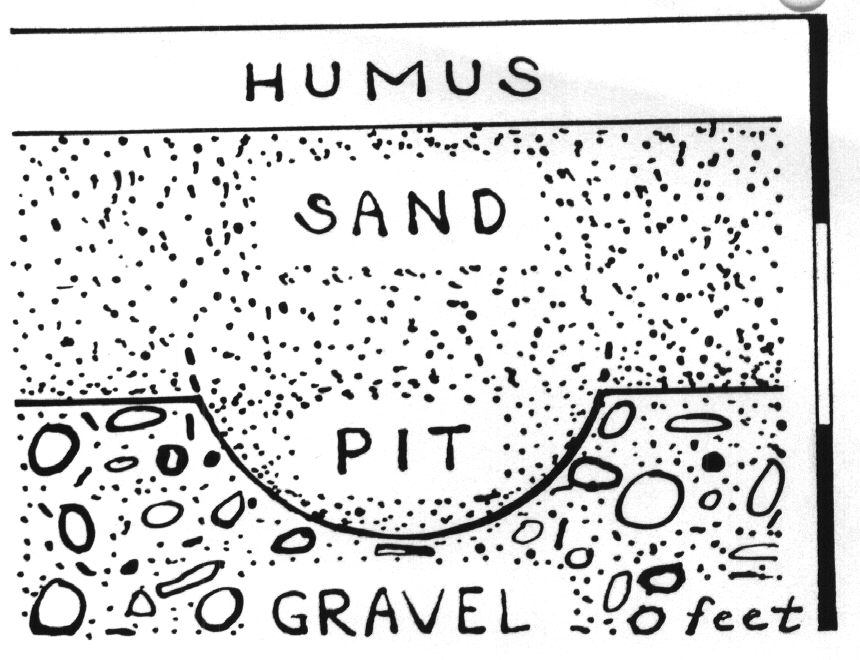Oconto
County WIGenWeb Project
Collected
and posted by Oconto County WIGenWeb Project
Collected
and posted by RITA
This
site is exclusively for the free access of individual researchers.
*
No profit may be made by any person, business or organization through publication,
reproduction, presentation or links to this site
.Copper Culture Burial Site.
Oconto County, Wisconsin
contributed by: Sarah
Baldueck -
from the family heirloom scrapbook
of her grandmother, believed published in the
Oconto County Reporter, date
unknown.
To
the Copper Culture Main Page
(Note: the time of this article's
writing is in the early 1950's, shortly after the site was discovered.
Scientific analysis has progressed tremendously since that time, and many
of the conclusions have undoubtably changed. The purpose of this posting
is to share these historic findings as of the time they happened - Rita)
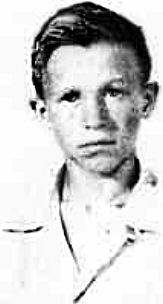
13 Year Old
Donald Baldwin who discovered the Copper Culture
Burial ground in June 1952. |
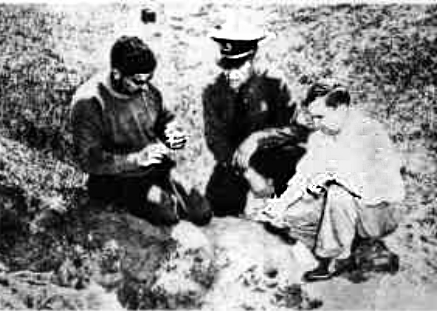
Oconto County Reporter Reuben LaFave, Oconto County
Archeologist, Police Chief Henry Toole Oconto, and George E. Hall, President
of the Oconto County Historical Society inspecting relics at the Old Indian
Burial Grounds a short time after the discovery was made. |
THE OCONTO SITE
AN
OLD COPPER MANIFESTATION
By Robert
E. Ritzenthaler and Warren L. Wittry
Introduction
The purpose
of this preliminary paper is to present a descriptive report of a
recently
discovered Old Copper site on the western outskirts of the city of Oconto
in Oconto
County, Wisconsin. The importance of the site lies in the fact that it
is
only the
second instance of Old Copper artifacts found in situs with burials, the
first
being the Osceola Site in Grant County, Wisconsin, discovered and excavated
in 1945.
While Osceola added some important information to this little-known
culture
of Wisconsin, it was obvious that more such sites were necessary for
comparative
purposes and to expand the picture of the life of these early
Wisconsin
inhabitants. The Oconto Site provided valuable data along these lines.
It has
been generally believed that the Old Copper people were the earliest
Indians
to inhabit Wisconsin, and estimates run as much as 5000 years ago for
their
arrival. Their name is derived from the fact of their having made a
considerable
variety of tools and ornaments out of Lake Superior copper by the
processes
of cold hammering or heating and hammering. The copper artifacts,
most of
which have occurred as surface finds, are distinctive for their thick coat
of copper
salts and heavy acid erosion which suggest considerable antiquity.
The Osceola
Site (Ritzenthaler, 1945) showed that a-long with such Old Copper
artifacts
as socket-tang spear points, spuds, knives, awls, conical points, beads,
and bracelets
there occurred a rather distinctive chipped-stone industry. The
chipped-stone
work exhibited fine workmanship in primary flaking and secondary
retouching,
and included in its products a characteristic type of drill, scraper, and
point.
The points were consistent in having a lanceoate shape with rather parallel
sides,
side notching, and a concave or sometimes straight base. Two bannerstones,
of the
"bow-tie" and prismoidal type, found by amateurs at the site provide evidence
that they
also made ground-stone artifacts.
Their burial complex consisted of interment in a cemetery (no mounds) and
the
employment of the bundle burial method as most common, but partial cremation
was also practiced. Their type of implements indicate an economy based
on
hunting and fishing.
With this rather meager picture of Old Copper culture the Oconto Site was
approached. One chief objective was to obtain enough charred wood for a
Carbon
14 analysis as to accurately date this group. We were also interested in
getting
information on house type, ground-stone work, and in obtaining data which
could
be compared with Osceola in terms of burial practices, and types of copper
and
chipped-stone artifacts.
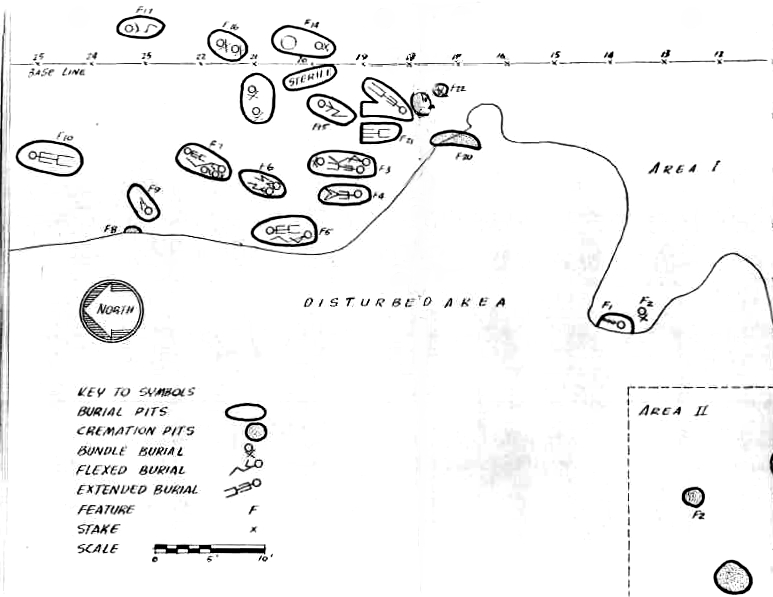 Diagram of the archiological
dig site
Diagram of the archiological
dig site
|
The Oconto
Site
The Oconto Site
was discovered in June, 1952, by Donald Baldwin, a 13 year old
boy, while digging
in an abandoned gravel quarry on the western outskirts of the
city of Oconto.
His discovery of human bones was investigated by Mr. Reuben
LaFave and Mr.
George Hall of the Oconto County Historical Society, and their
test excavations
revealed burials accompanied by copper artifacts. The find was
reported to
the Milwaukee Public Museum, and two members of the anthropology
department made
a one day trip to examine the site and artifacts obtained thus
far. Arrangements
were made to excavate the site, and on July 16th, Mr. Warren
Wittry representing
the Wisconsin State Historical Society, and Mr. Robert
Ritzenthaler
and Mr. Arthur Niehoff of the Milwaukee Public Museum arrived at
Oconto and began
work. The project was conducted as part of the program of
the Wisconsin
Archeological Survey.
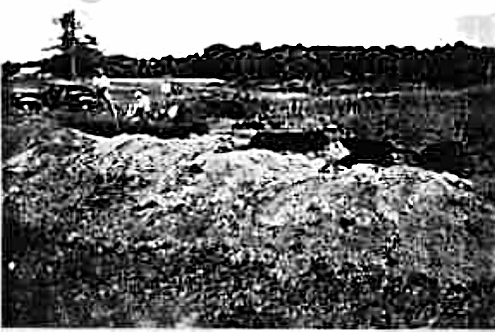 General View of Site
General View of Site
|
The site lies within the western limits of the city of Oconto with the
burial area about 150 yards north of the Oconto River. Specifically it
is within Part 4 of Government Lot 8, Section 24 of Oconto Township, and
is now the property of the Oconto Historical Society. The area was formerly
a fairly level one1, but commercial gravel operations during the 1920's
removed and disturbed a large area and there is little doubt that a considerable
portion of the burial site was destroyed in the process. It is probable
that the burial site originally enclosed an area at least 100 feet square.
There is no indication of mounds. Beneath the eight-inch topsoil lie several
feet of Plainfield fine sand, underlain by gravel.
Method
of Excavation
A base line running north-south was established nd a five-foot grid system
employed. Excavation procedure was to strip a square rapidly down to the
bottom of the approximately eight inches humus layer which was sterile
except for quantities of sawn animal bones existing as refuse from a slaughterhouse
formerly located just to the east of the burial area. When the yellowish
sand lying below the humus line was reached, stripping proceeded more cautiously
as occasional copper implements (particularly awls) were found only a few
inches below the top of the sand layer. Near the bottom of the roughly
two foot deep sand layer, the burial pits would begin to show up.. The
burial pits were rectangular as seen from above, roughly two by four and
one-half feet in size, and basin-shape in cross-section.
They had been dug into the gravel, the burials laid-in and covered with
sand,
so the pits were discernible by the gravel outline when approached from
above.
The cremation pits appeared as roughly circular when seen from above,
basin-shaped in cross-section, and in instances did not penetrate into
the
gravel layer. Each pH was given a feature number.
The
Burial Complex
Nearly all the burials occurred in pits, and both burial pits and cremation
pits were
found. Eighteen burial pits were discovered, with one of these sterile.
Three
others had been discovered by Mr. LaFave before our arrival. While the
usual
size was about two by four and one-half feet, they ranged in length from
four to
eight feet, and in width from two to nearly four feet. The shape was rectanguloid
as seen from above, with rounded corners, sometimes to the extent of resulting
in
the outline being more elliptical than rectanguloid.
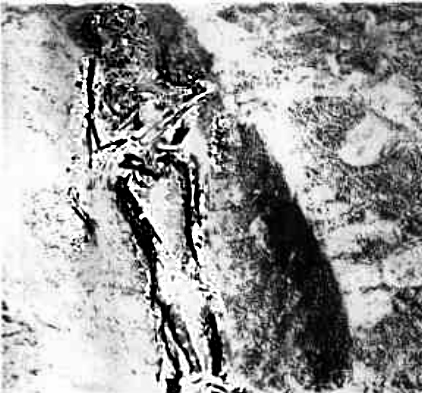 Feature 10 showing pit shaped and extended
burial
Feature 10 showing pit shaped and extended
burial
|
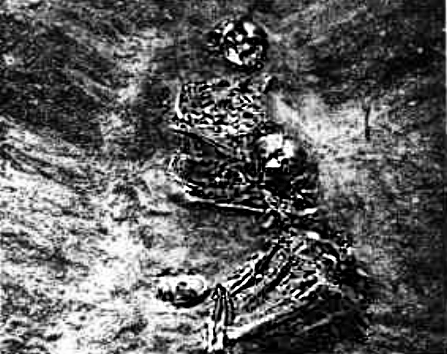 Feature 7 showing partial flexed burial with shull
of bundle burial near pelvis, and skull of child and two antler tips near
feet.
Feature 7 showing partial flexed burial with shull
of bundle burial near pelvis, and skull of child and two antler tips near
feet.
|
They were basin-shaped in vertical cross-section and from one to two
feet in depth. Most were "custom dug." just large enough to house
the individual or individuals interred. Of the twenty-one burial pits,
one contained nothing, eleven contained a single individual, seven contained
two individuals, one contained three, and one contained five. A variety
of burial positions were sometimes found to occur in a single pit.
In Feature 7, for example, there were three bundle burials, one partially
flexed, and one extended. In the two instances in which the secondary burials
occurred in the same pit with primary ones, the secondary burials were
above the primaries. Apparently the individuals who died in the winter
were kept until the spring thaw made digging possible. Then the recently
dead were interred in the flesh and the bones of those left over
from the winter were thrown on top as secondary burials. In eight of the
pits one or more artifacts were found, but there was no consistent or significant
position of artifacts in relation to the skeleton.
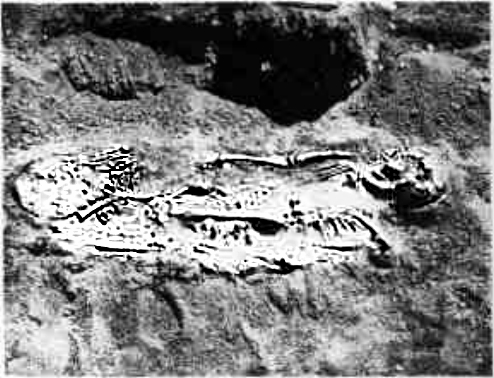 Feature 5 Double burial in pit showing
whistle at back of head of child (left - center)
Feature 5 Double burial in pit showing
whistle at back of head of child (left - center)
|
The bone whistle, however, lay at the back of the head of the child.
(See Webb, 1950, p. 291, for a similar occurrence.) Thirteen of the pits
were orientated with the longitudinal axis running in a roughly north-south
direction, but there seems to be no significance to it, as some had an
east-west orientation and others fell somewhere in between. Furthermore,
there seemed to be no pattern as to how the individuals were faced. A total
of seven cremation pits were discovered plus one reported by the LaFave
excavation. They were roughly circular as seen from above, and basin-shaped
in vertical cross-section. Their diameters ranged from two to four
| Method |
Number of Individuals |
| |
certain probable |
| Extended |
9 (2 of these were prone positions) |
| Partially flexed |
4
3 |
| Fully flexed |
3
1 |
| Bundle |
12 |
| Partial cremation |
8 pits (number of individuals un-known) |
| (Unidentified) |
5 |
| Total |
45 individuals |
Physical type:
A study of the skeletal material has yet to be made, but it is
readily apparent that they were a fairly robust group, of average stature
for Wisconsin Indians, but with well-developed musculature. The state
of bone preservation ranged from fair to very poor.
Evidence of Occupation
Besides the cemetery there was little in the way of evidence of occupation.
Copper implements, particularly awls, occurred sporadically in the upper
levels of the sand layer and bore no apparent relationship to the
burials. Four chipped-stone points were found apart from an association
with burials. It is probably that they represent lost or discarded items.
Numerous post molds were found and mapped, but no discernable pattern was
apparent. A considerable number were of consistent size usually 8 feet
in diameter, and in some cases three or four would line up with fairly
consistent spacing and direction, then abruptly end. Fragments of charcoal
were found in two of the molds. The end product was a map showing
such disorderly scattering that no resemblance of a wall or house
could be ascertained.
Artifacts
A detailed
list of the Oconto specimens with description, measurements, and association
appears as Appendix A of this report. This section will concern itselfwith
a summary of the types found and comparisons with Osceola materials.
Copper:
Oconto yielded fewer copper artifacts and fewer types than Osceola.
There was a total of 26 specimens found, including those dug by local
residents and turned in for measurement and photographing.
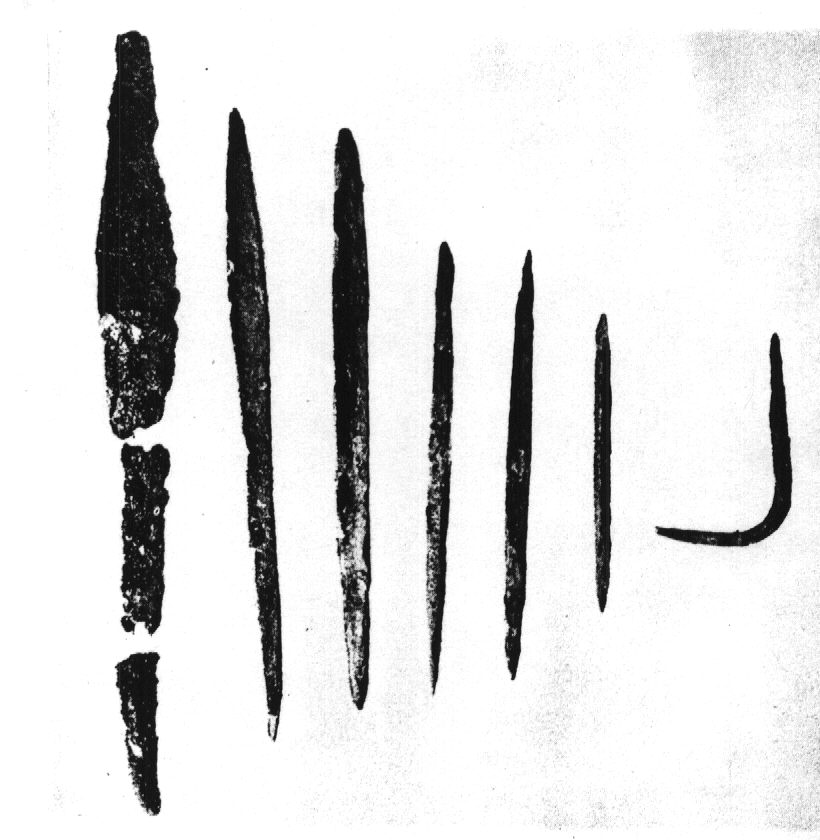 AWLS
AWLS
|
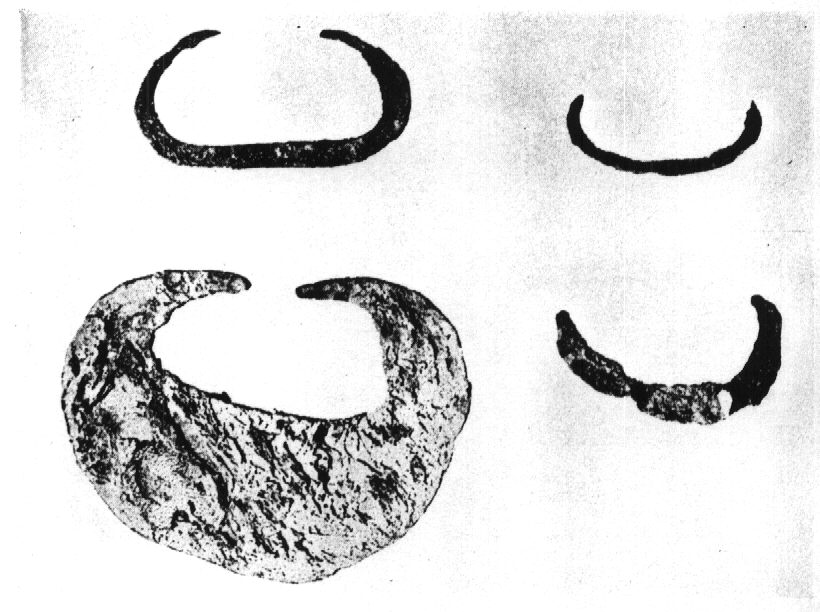
FOUR CRESCENTS
|
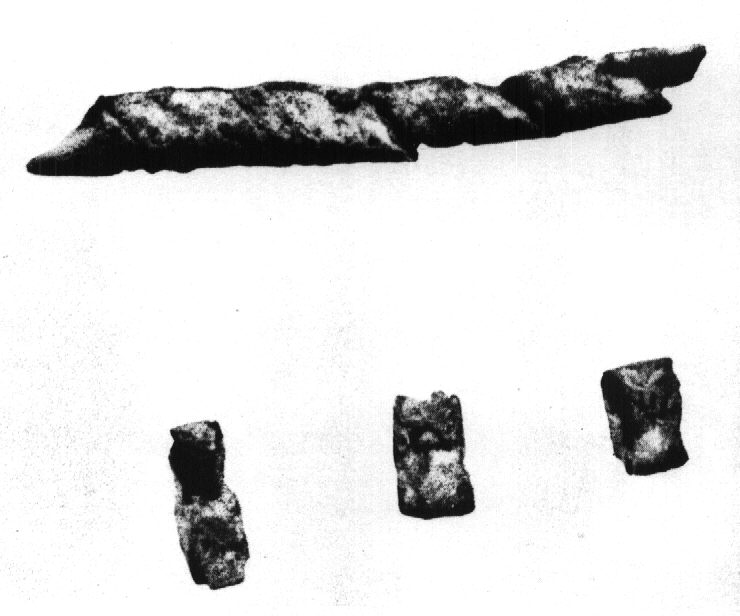
THREE CLASPS (bottom)
|
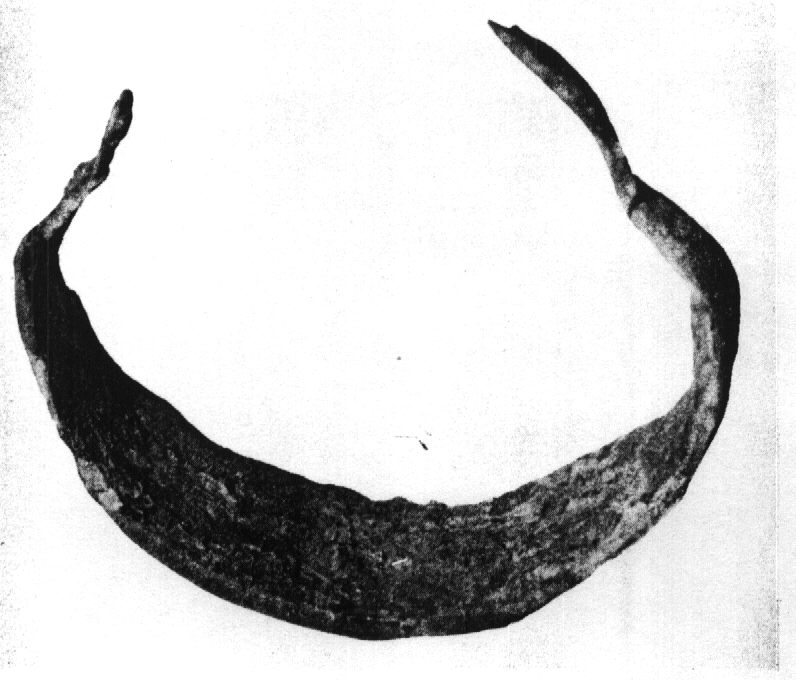 BRACELET
BRACELET
|

PIECE OF SPIRAL-COILED TUBING
(top)
|
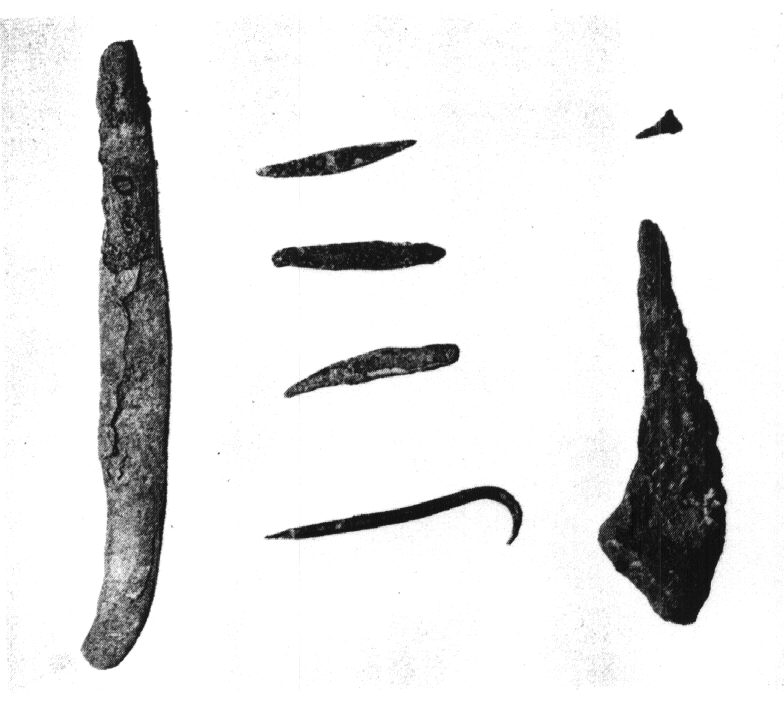
SPATULA (right), FISHHOOK, RIVET (left bottom), and
4 UNIFENTIFIED PIECES
|
The types are listed as follows:
Seven awls , four crescents, three clasps, and one each of the following:
spear-point with broken tang, fishhook, bracelet, section of spirally-coiled
tubing, rivet, and spatula. There were also four small unidentified
pieces.
As with
Osceola, awls were the most numerous type of artifact, but the Oconto specimens
were of smaller size.
Crescents were more numerous at Oconto, but in contrast with Osceola no
spuds were found and only one socketed-tang spear-point. At both
sites utilitarian products were much more numerous that the ornamental.
Chipped
Stone
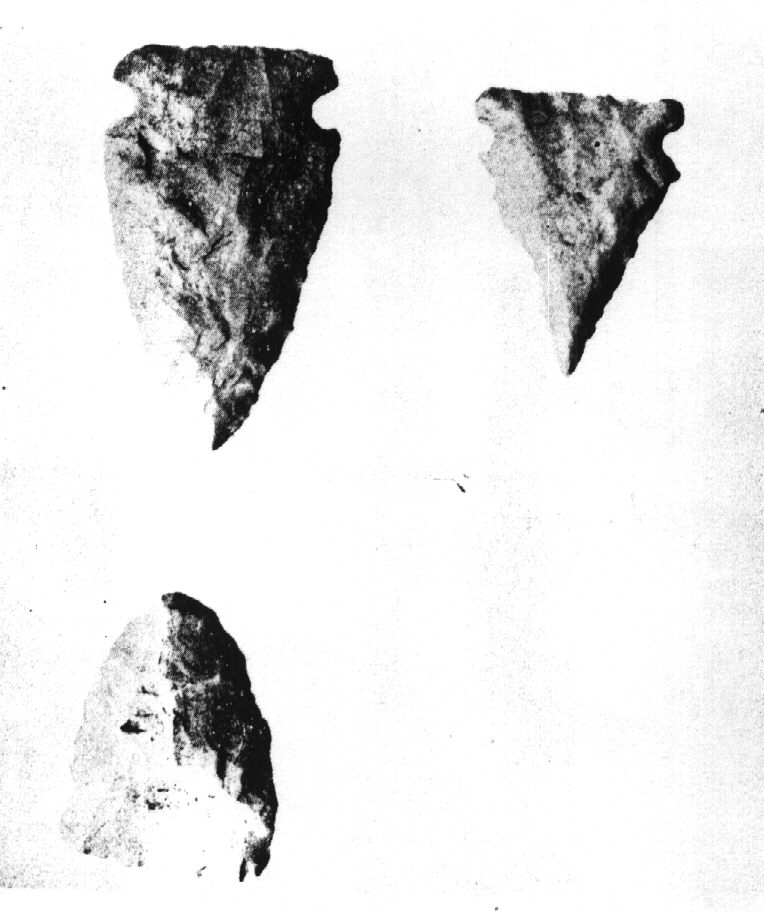 TWO PROJECTILE POINT (top)
TWO PROJECTILE POINT (top)
SCRAPER (bottom)
|
Somewhat surprising, in contrast to Osceola, was the paucity of chipped-stone
implements. A total of seven such artifacts were found, with only three
being associated with burials. Of the remaining four, one, a straight-stemmed
point fragment, occurred in the humus layer and could represent a different
culture, one was found in a disturbed area and stratigraphy could not be
determined, and two were near the top of the sand layer. All were projectile
points with the exception of one, a triangular scraper found with a burial.
Of the two points found with burials one was triangular in basic shape
with the side notches, but the sides of the blade appear to be re-chipped;
the other was ovoid with a straight base and side notches. The latter
was the nearest in type to the Osceola type, but none were characteristic
Osceola points. Besides the variation in type, the Oconto points
were smaller, none being over two inches in length. Like Osceola, however,
the technique of primary flaking with secondary retouching along the edges
was employed.
Bone:
 WHISTLE
WHISTLE
|
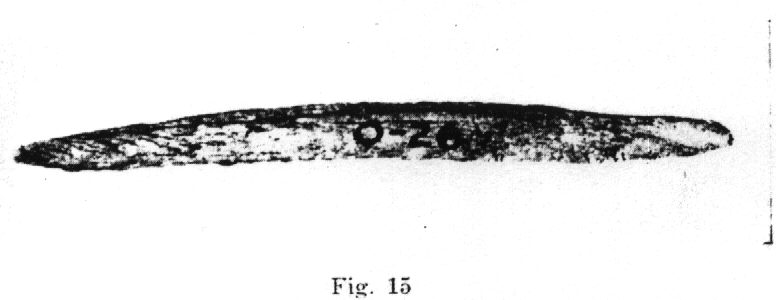 AWL
AWL
|
Two bone artifacts were found, the first bone Implements to be associated
with the Old Copper complex thus far. The most interesting was a fine specimen
of a whistle made from a leg bone of a swan. It was six inches long with
a rectangular opening near the center, and three rows of
short, incised lines running the full length as decoration. The
second specimen was a awl 2 5/8 inches in length and made from a
portion of a fish jaw.
Antler:
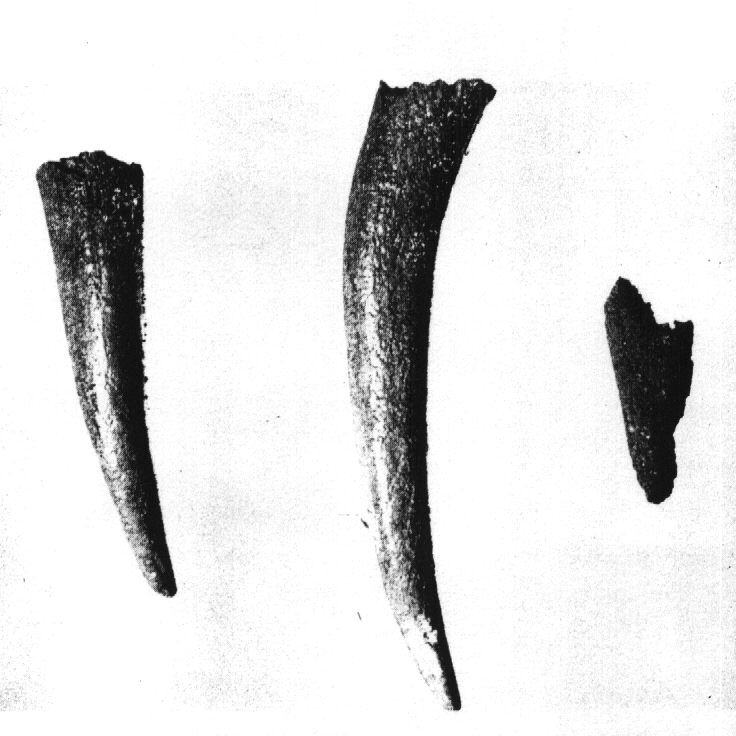 ANTLER TIPS
ANTLER TIPS
|
Two well-preserved antler tips, suitable for use as flaking tools although
the polished ends gave no indication of such use, were found together in
a burial bit. A third specimen, a charred short end-section occurred in
a concentration of charred wood.
Shell:
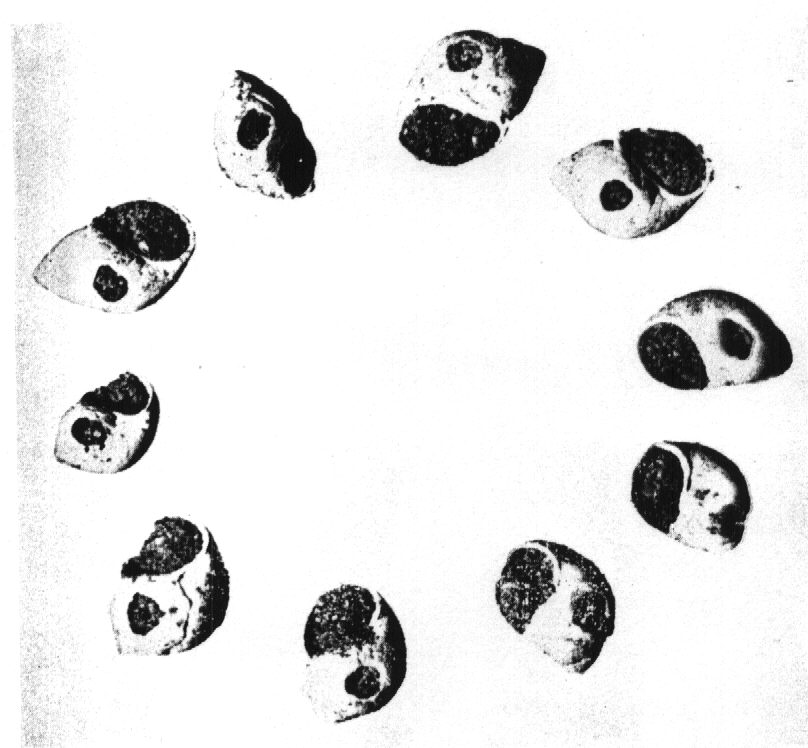 POND SNAIL BEADS
POND SNAIL BEADS
|
A series of 14 pond snail (Campeloma decisum) beads plus fragments of
several more were found with a burial before our arrival. They were reported
as occurring at the wrist of the skeleton and apparently 1/8 inches in
diameter near the center with the stringing presumbably done through this
hole and the natural aperture.
Portions of two unworked shells were also found in a burial pit. One was
a
fresh-water clam {Unio ellipsis), the nearest present source of which is
the
Mississippi River. The second was part of the shoulder of a large lightning
shell, a
type of whelk (Fulgar perversus) the present distribution of which is the
Atlantic
Coast from North Carolina to Florida. It was from a shell originally about
a foot
in length, and its importance lies in its indication of trade or contact
with a region
over a thousand miles away.
Hematite:
Two lumps of iron ore were found near the head of the extended child burial,
with which the bone whistle was found. A rounded facet, apparently of natural
origin, appears on the smaller of the two.
Pottery:
No pottery
was found.
Animal
Remains:
Near the
head of an extended burial in a pit, Feature 4, were found a number of
small
bones. They were indeati-fied as parts of turtle and a duck (unidentified
as
to species
but about the size of a mallard).
Conclusions
While the
Oconto and Osceola sites are obviously closely related in culture and
must be
considered as belonging to the Old Copper Culture, it is also apparent
that
there
are a number of differences between the two. The variation is most strongly
evident
in the chipped-stone types, but the differences also exists in terms of
types
of copper artifacts, burial methods, bone and antler work, and polished
stone.
To a considerable
extent it is merely the absence of a trait, such as bone work for
Osceola,
that creates the difference, and it is very possible that what we have
here
are inadequate inventories of the culture at both places. Future excavation
might
fill in these gaps to the extent that such negative variations will cancel
out.
The variations apparent at this point could be theoretically accounted
for on either
special or temporal grounds, or both. Considering the special approach
the two
sites are at opposite ends of the state some 210 miles apart as the crow
flies. If
contact were lacking, the variation could easily occur within a relatively
short
period of time. As to a temporal difference, there is no evidence to indicate
either
that one is older than the other, or that they were contemporaneous. It
might be
noted that Oconto is near the heart of the Old Copper center as indicated
by
distributional studies based on surface finds (Wittry, 1951, pp. 14, 18)
while
Osceola exists as a lonely outpost, but it is impossible at this point
to determine
which group was the earlier.
Concerning
the problem of dating, there was nothing at either site to dispute the
theory that Old Copper represents an archaic horizon in Wisconsin, and
that these
were the earliest Indians to occupy the site. The Oconto site, in fact,
bolsters this
theory because of such evidence as the absence of pottery and the bone
whistle of
a type found in archaic sites outside the state (see Ritchie, 1944, p.
294, and Webb,
1946, p. 305). As for more precise dating, enough charred wood was obtained
at
Oconto for a carbon 14 analysis and it is hoped that the forthcoming analysis
will
provide the answer to the problem of the age of the Old Copper culture
in Wisconsin.
BIBLIOGRAPHY
* Ritchie, William A., The Pre-Iroquoian Occupations
of New York State. Rochester Museum Memoir No. 1, 1944.
* Ritzenthaler, Robert E., The Osceola Site. Wisconsin
Archeologist. N. S. Vol. 27, No. 3, Sept. 1946.
* Webb, Wm. S., Indian Knoll. University of Kentucky
Reports in Anthrop. and Arch., Vol. 4, No. 3, Part 1, 1946.
* 覧覧覧覧覧覧覧, The Carlson Annis Mound.
University of Kentucky Reports in Anthrop. antl Arch., Vol. 7, No. 4, 1950.
* Wittry, Warren L., A Preliminary Study
of the Old Copper Complex. Wisconsin Archeologist N. S. Vol. 32, No. 1,
Mar. 1951.
BACK
TO THE OCONTO COUNTY HOME PAGE




